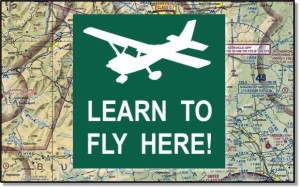As a recently licensed private pilot, I feel truly alive when flying a small plane. In a single flight I can feel pride, humility, fear, joy, and triumph. This list of feelings also crops up on a regular basis for my co-founder and me as we work to build our publishing startup, causing me to reflect on the similarities between learning to fly and building a startup. Here are my top five flying lessons that also apply to my startup efforts:
1. Practice, Fail, Learn.
There is nothing stickier than a lesson learned by f’n it up the first few times.
We had just landed, and the 1946 Champ rolled down the runway at good clip when my instructor told me to take over and taxi us back to the hanger. Feeling confident that we were safe on the ground, I took the stick. For the first few hundred feet I had things under control. In an instant, I felt the back end of the plane start to swing to the right. My instructor called for more right rudder, but I reacted too slowly. The plane made an abrupt left turn, the left wing dipped and almost struck the ground. Finally, the plane came to a quick stop sitting in the middle of the grass runway. My instructor said, “That’s what we call a ground loop. Now let’s learn how to not break my plane.” The rest of the lesson consisted of me taxiing up and down the runway, learning to control exactly where the plane was going.
I learned to taxi, fly, and land the Champ by making lots of little mistakes, recognizing them, and correcting them next time.
Startup founders also learn by doing, in some combination of try, fail, re-try, fail less, and succeed. The willingness to embrace this cycle propels founders to new levels of success and creates positive outcomes such as inspiring investors to double down, even if the founders have had a ground loop or two.
2. Balance Risk.
Flying a small plane involves risk. The thin margin for error, with small errors often compounding to create larger errors, sometimes leads to deadly outcomes. Disaster unfolds gradually—you’re in a hurry to get back home so you don’t top off the fuel tanks, head winds are a little stronger than forecasted so fuel burn rate increases, you could divert to a closer airport but that’s not home, and after all, you should be able to make it…. Should…
Private pilot instruction aims to reduce the risks of flying and to train flyers to be better decision makers. We use checklists to inspect the plane for defects, we practice emergency procedures to mentally and physically prepare ourselves for the shock of a true emergency, we monitor and respect the weather and its impact on our fight plans, we monitor our personal well being and fitness to fly, and we make a Plan B and a Plan C in case things don’t go as expected.
Launching a startup involves risk too, but fortunately as compared to flying, the margins for error are much larger. As startup founders, we put our personal savings at risk, we postpone or cancel education or career plans, we place stress on personal relationships, and face the risk of failing in public. Experienced founders balance these risks by planning, testing, and measuring. We talk to potential customers before building the MVP, we gauge customer demand before investing time and money, we perform due diligence before taking investor money, and we spend small before we spend big.
3. Embrace the Bumps.
I learned to fly in Western North Carolina in the Blue Ridge Mountains.
The mountains can stir up a good amount of turbulence for a 1,500-pound Cessna. Sudden gusts can lift a wing dramatically, mountain wave currents blow so hard it seems like the plane is standing still, and a smooth flight turns into a jolting ride just by flying over seemingly benign ridges. The more you experience the turbulence, the more you become good at mitigating it—head to a different altitude for smoother air, keep a light touch on the controls and don’t overreact to each bump or dip, and ultimately make small corrections or none at all. Or if it’s too rough, call it a day and head for the airstrip and reconnect with the Earth.
Any founder that’s been at it for a while knows that building a new company also offers a bumpy ride. Customers complain, investors back out, employees quit, servers crash, your significant other is pissed, and it’s just Tuesday. Thankfully, the triumphs along the way make continuing the journey worthwhile, and you get better at managing the bumps and setbacks.
Ride out the bumps and setbacks, make adjustments as needed, and keep your focus on the most important checkpoints in your flight plan.
4. Don’t Run Out of Fuel.
Obvious, right? You would think so, but a surprising number of small plane crashes are the result of running out of gas, otherwise known as “fuel exhaustion.” Several pre-flight checks center on making sure there is good gas in the plane—check the fuel gages, pull the cap off the tanks and measure with a calibrated stick, pull a sample of fuel from the sumps to make sure no water condensed in the tanks, and even confirm the color of the fuel matches expectations. In a single engine small plane, the prop quits turning when you run out of fuel, forcing your next move—an “off airport” landing. With luck, you spot an open field or a clear stretch of road and put it down with out damage or injury.
While building any startup venture, you’ll have frequent reminders that cash fuels the business and that when you run out of cash, you are out of business. Again, it sounds obvious to manage startup cash reserves carefully, but many founders give in to the temptation to spend all the way up to the point of “cash exhaustion,” hoping that just one more AdWords spend will get enough users signed up, or an expensive trade show will get the orders needed to make payroll. Startups succeed by winning many small victories, achieved over a long period of time. And the only way you get the privilege of being around a “long” period of time is by planning your cash burn carefully, placing numerous small bets on activities you know will pay off, and staying willing to divert to plan B if cash runs low.
5. Land the Plane, Dumbass.
Near the beginning of my flight training I was having trouble getting my landings down. I repeatedly added too much power, causing the plane to come in too high on final approach. Other times, I brought the plane in too low, getting a much too close view of the power lines. After a few of these botched attempts, I asked my instructor to “coach me through a landing.” Without missing a beat, he said, “Land the plane, dumbass!” His comment caught me just right, and we laughed all the way through the base (next-to-last) leg of the landing pattern. I settled down, turned final, and brought it in for one of my best landings, ever. During our debrief back at the hanger, we laughed again and my instructor explained that I knew the steps for a great landing, so I needed to relax, enjoy flying, and keep practicing. Two lessons later, I soloed for the first time.
As startup founders, it’s easy to get impatient with our progress. We are focused on big goals that are as critical as landing a plane, such as publishing a new title, launching our MVP, or closing a major customer deal.
When I find myself mired in challenges of the day and frustrated, I pause to relax, follow the steps I planned, laugh at myself as required, and focus on bringing the plane in for a landing.

